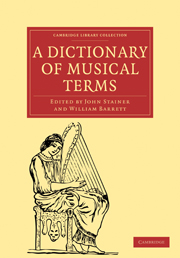G
Published online by Cambridge University Press: 10 November 2010
Summary
G.(1) The note Lichanos in Greek music. [Greek Music]
(2) The first note of the church mode, called Eolian, the highest in pitch of the authentic modes.
(3) The lowest note of the grave hexachord; in the Guidonian system, gamma ut.
(4) The fifth note of the normal scale of C, called Sol.
(5) The lowest or fourth string of a violin, the third of the viola and violoncello.
(6) The key-note of the major scale, having one sharp in the signature.
(7) The letter-name of the treble clef.
G. abb. for gauche (Fr.) Left; as, m.g., with the left hand.
Ga. The fourth syllable in the system of Bobibation.
Gabel (Ger.) A fork; Stimmgabel, a tuningfork; Gabelton, the note A, as given for the pitch.
Gagliarda (It.) [Galliard.]
Gai (Fr.) Gajo (It.) Lively, merry, gay.
Gaillarde (Fr.) [Galliard.]
Gaiment (Fr.) Gajamente (It.). Gaily, cheerily, merrily.
Galantemente (It.) Gracefully, in good taste, bravely.
Galliard, Gaillard (Fr.) Gagliarda (It.) An ancient dance, so called because of its gay rhythm and motion. It is said by some to have been similar in character to the Cushion dance, and is described by Sir John Davis as:
—“A swift and wandering dance,
With passages uncertain to and fro
With lofty turns and caprioles in the air,
Which to the lusty tunes accordeth fair.”
Like the minuet, of which it was probably the parent, the galliard was danced by a lady and gentleman. If more than one couple performed the dance, they did so independently of other dancers.
- Type
- Chapter
- Information
- A Dictionary of Musical Terms , pp. 193 - 215Publisher: Cambridge University PressPrint publication year: 2009First published in: 1876



